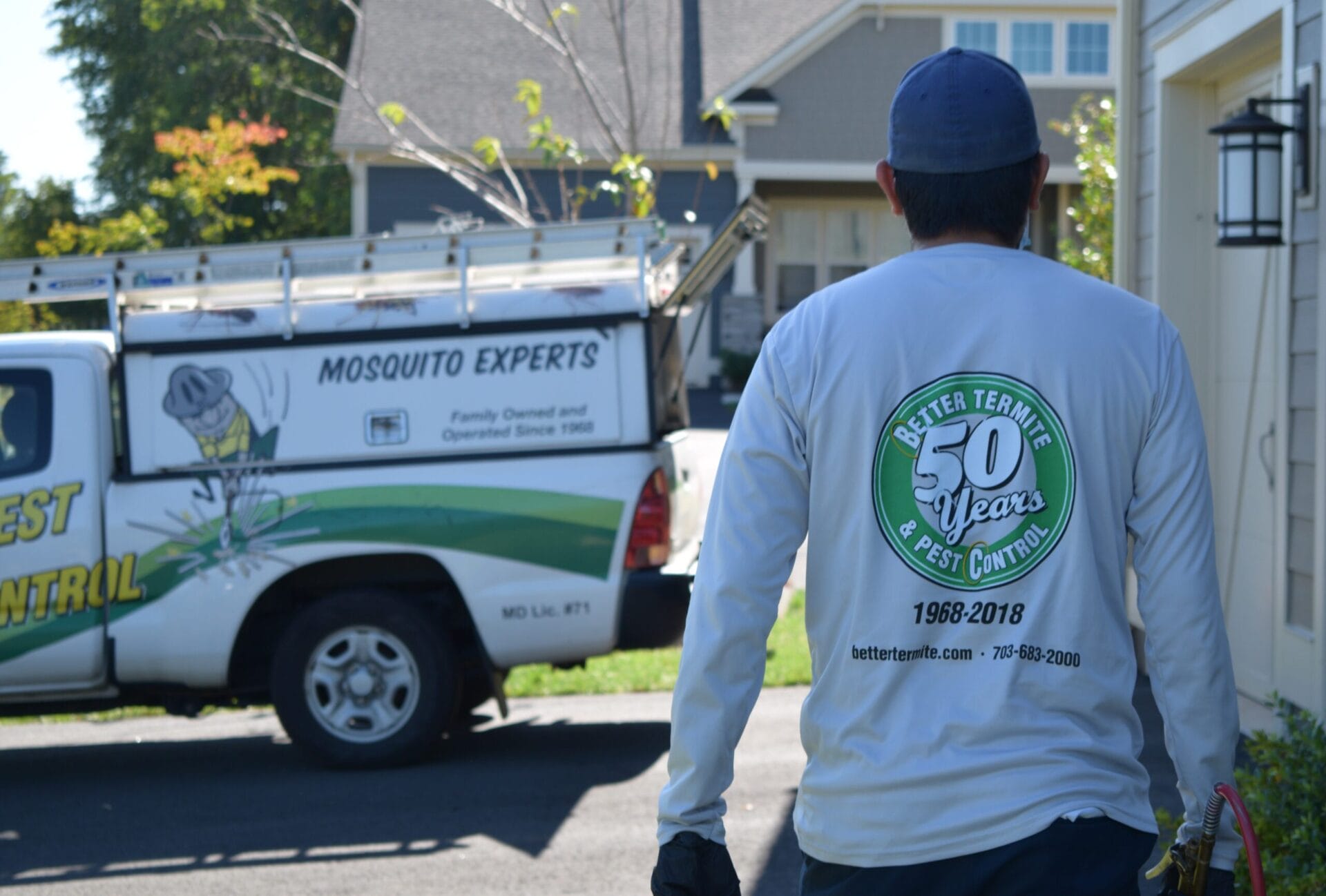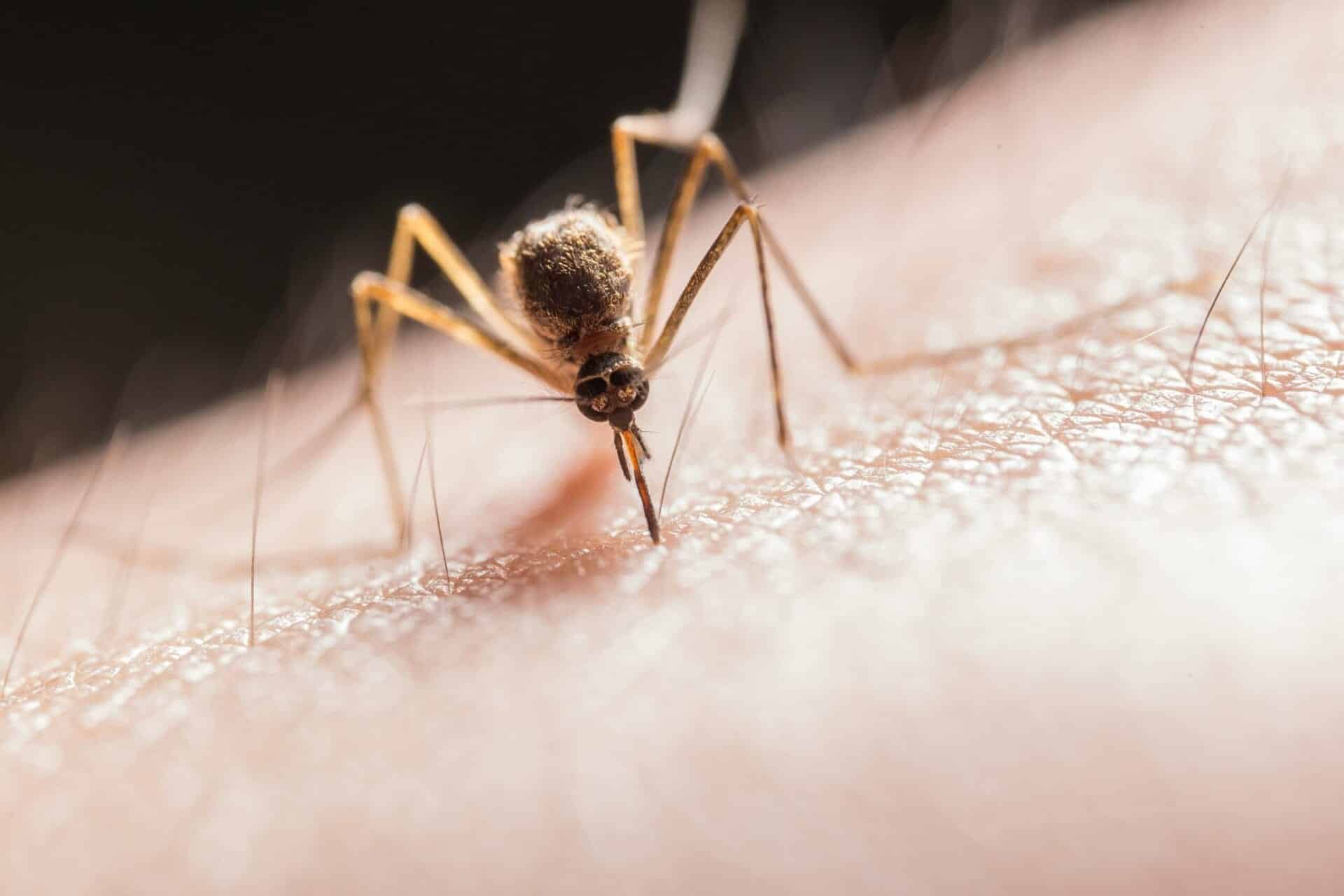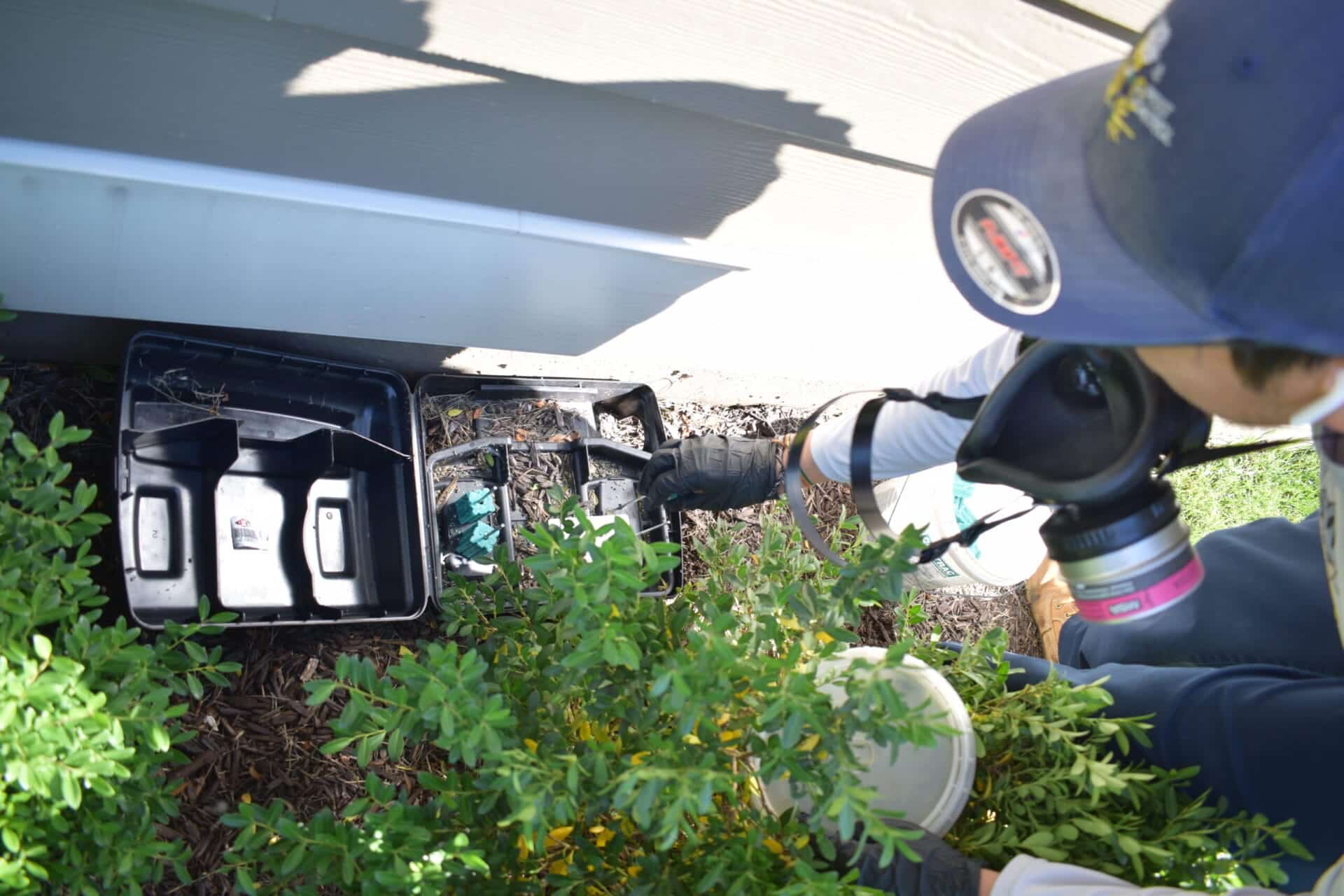


Finding small, silver insects darting across your bathroom floor at night? You’re probably dealing with silverfish. These moisture-loving pests have made bathrooms their favorite hangout spot for good reason. High humidity, paper products, and plenty of hiding places create the perfect environment for these nocturnal creatures.
After working in pest control for four years and seeing countless silverfish issues throughout the DMV area, I’ve learned that bathrooms present unique challenges. Our family business has been tackling these problems for over 50 years, and silverfish remain one of the most common calls we receive from homeowners in Virginia, Maryland, and the District of Columbia.
Humidity is the main draw for silverfish in bathroom spaces. According to the University of Florida’s entomology department, silverfish need 75-95% relative humidity to survive. Your bathroom delivers exactly what they’re looking for, especially during hot showers and poor ventilation.
The temperature range also works in their favor. Silverfish thrive between 72-81°F, which is basically the comfort zone for most households. Additionally, bathrooms trap humid air in structural voids around plumbing and behind baseboards.
Food sources are everywhere in your bathroom, even if you don’t realize it. Silverfish feed on cellulose-based items like toilet paper rolls, cardboard packaging under the sink, and cotton towels. They also eat the starch found in wallpaper paste, which explains why you might see damage around your walls.
But it doesn’t stop there. These pests will munch on soap residue, dandruff, shed skin cells, and hair. Basically, your daily routine provides a buffet for silverfish in bathroom environments.

Hiding spots are plentiful around plumbing fixtures and vanity areas. The structural voids around pipes create dark, humid spaces that remain undisturbed between uses. This gives silverfish the perfect place to establish their colonies without being detected.
The appearance is pretty distinctive once you know what to look for. Silverfish have silvery-gray scales that reflect light, giving them that metallic shine. Their bodies are carrot-shaped, tapering from a wider head down to three bristle-like tails.


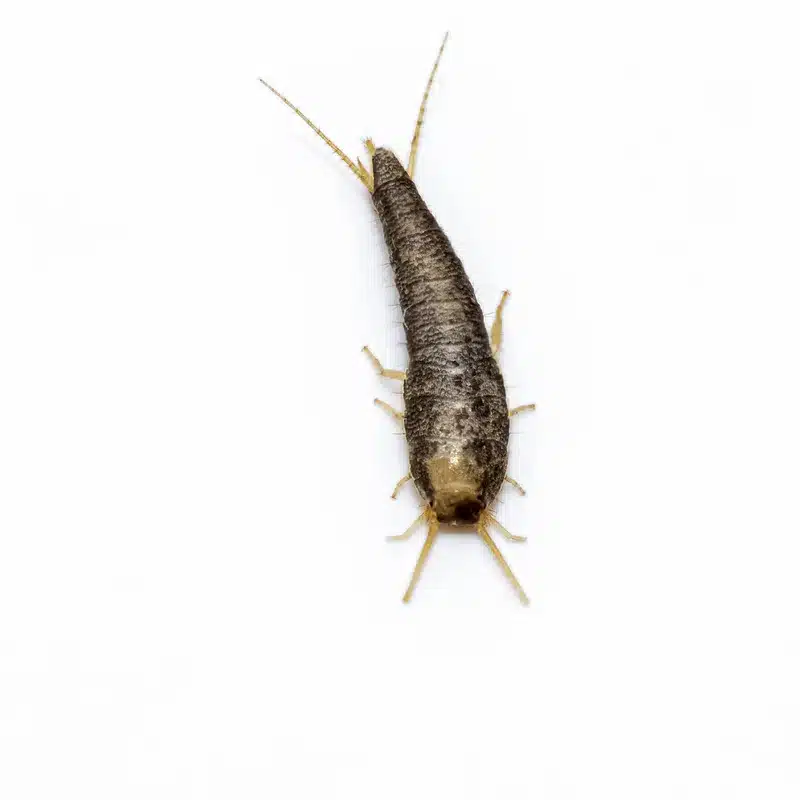
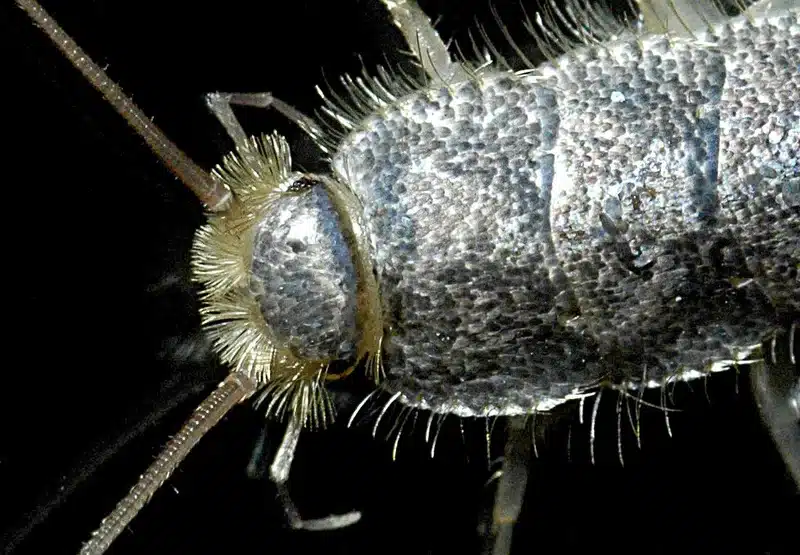
Most silverfish measure between 12-19 mm long, roughly half to three-quarters of an inch. The Virginia Tech extension office notes that their small compound eyes help them avoid light, which explains their nocturnal behavior.
One thing that sets silverfish apart is their serpentine, fish-like movement. They’re extremely fast for their size and seem to wiggle across surfaces rather than run in straight lines. This motion, combined with their silver color, makes them easy to identify once you spot one.
Their lifecycle is pretty remarkable too. Silverfish are wingless and continue molting throughout their 2-8 year lifespan. They can molt up to 66 times, which is unusual among insects. Females lay up to 100 eggs in cracks and crevices, and these take anywhere from 2 weeks to 2 months to hatch depending on conditions.
Light avoidance drives their behavior more than anything else. Silverfish have what’s called negative phototaxis, meaning they actively move away from light sources. This is why you typically see them scurrying away when you flip on the bathroom light at night.

During daylight hours, silverfish retreat to their hiding spots behind baseboards, under vanity kick-plates, or inside wall voids. They wait until darkness before coming out to forage for food and water.
Their foraging patterns are pretty predictable. Silverfish emerge after lights go off and make their way to food sources like soap scum, paper products, or organic matter. They follow the same routes repeatedly, which makes trap placement more effective when you understand their movement patterns.
The tiled surfaces in bathrooms actually work to their advantage because there’s low predation pressure. While house centipedes and certain spiders naturally control silverfish populations, bathrooms don’t typically harbor these predators in significant numbers.
Under sink cabinets rank as the number one hiding spot in most bathrooms. The area around P-traps stays humid and dark, plus there’s usually stored items like cleaning supplies and toilet paper that provide food sources. Check behind the cabinet kick-plate where silverfish often establish their main harborage areas.

Behind toilet tanks creates another prime real estate location. Condensation from cold water lines keeps the drywall damp, and the space remains undisturbed for long periods. I’ve found significant silverfish activity in this area during many inspections over the years.
Cracks in grout lines and caulk provide entry points and hiding spaces, especially where tubs meet walls. Over time, these sealants deteriorate and create perfect pathways for silverfish to move between rooms.
Other common spots include:
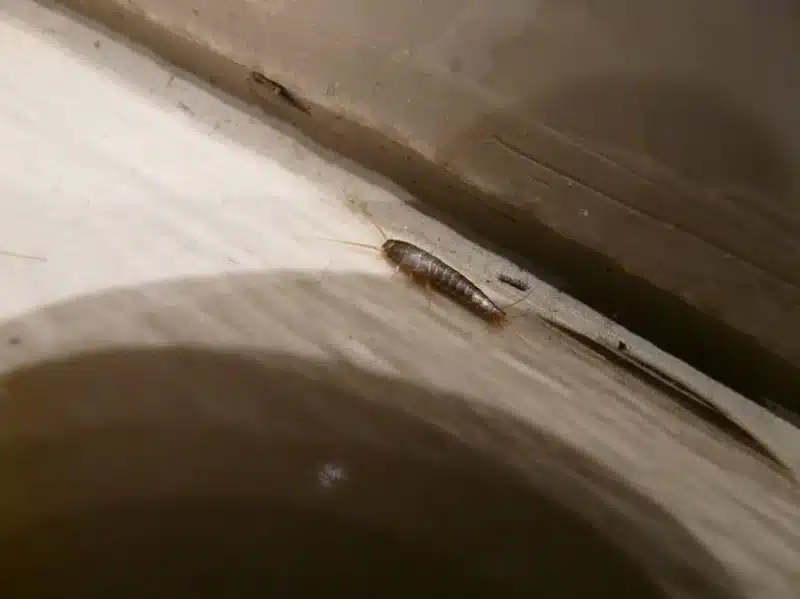
For more detailed information about silverfish behavior and biology, check out our comprehensive silverfish identification guide.
Paper products take the biggest hit from silverfish feeding. You’ll notice irregular scraping marks and notching along edges of books, magazines, or important documents stored in bathroom cabinets. The damage often appears as yellow stains from their excreta mixed with the feeding marks.
Wallpaper presents a special problem because silverfish target the paste behind the surface rather than the paper itself. According to the University of Maryland Extension, this feeding pattern causes blistering and peeling as the adhesive gets consumed.
Textile damage shows up as small holes or frass trails in cotton towels, linens, and fabric shower curtains. While not as destructive as moths, silverfish will feed on natural fibers when other food sources are limited.
Health considerations mainly involve allergens rather than disease transmission. Silverfish scales and waste products can accumulate over time and potentially trigger rhinitis or dermatitis in sensitive individuals. However, they don’t bite or carry diseases like some other pests.
The key point is catching silverfish activity early before populations grow large enough to cause significant damage. Regular monitoring helps identify problems before they become costly to fix.
Primary food sources center around starches and cellulose. Silverfish particularly love the starch found in wallpaper paste, book bindings, and cardboard packaging. They can actually detect these food sources through their antennae and will travel considerable distances to reach them.
Secondary protein sources come from your daily bathroom routine. Soap film contains fats and oils that silverfish consume readily. Dead skin cells, dandruff, and hair provide additional protein they need for growth and reproduction.
Sanitation plays a crucial role in silverfish control. Regular cleaning removes these food sources and makes your bathroom less attractive. Focus on areas where soap scum builds up, like shower doors and bathtub edges.
Silverfish can survive over 300 days without food if water is available, which makes moisture control even more important than perfect sanitation. Still, removing easy food sources forces them to work harder and potentially move to other areas.
Cleaning frequency should increase in high-humidity periods. During Virginia and Maryland’s humid summers, silverfish activity peaks because both moisture and food sources become more abundant. Weekly deep cleaning of soap residue and organic matter helps break their feeding cycle.
If you’re dealing with similar moisture-loving pests, our guide on millipede identification and control covers comparable prevention strategies.
Target humidity levels should stay at 50% or below to make your bathroom unsuitable for silverfish. This single change eliminates their ability to survive long-term, even if food sources remain available.
Dehumidifier placement works best in adjacent closets or hallways where the unit can process air from multiple rooms. A 50-70 pint per day capacity handles most bathroom humidity issues in typical DMV-area homes.
Ventilation best practices include running exhaust fans for at least 20 minutes after showering. Many homeowners shut off fans too quickly, which allows humidity to build back up rapidly. Consider installing timer switches that automatically extend fan operation.
Regional climate challenges make humidity control especially important in our area. Virginia and Maryland summers routinely deliver 65-75% outdoor humidity, which translates to over 80% indoor humidity in poorly ventilated bathrooms. This creates ideal conditions for silverfish year-round.
Additional moisture control steps include:
The Virginia Tech Extension office emphasizes that moisture management forms the foundation of any successful silverfish control program.
Caulking gaps around baseboards, tub rims, and utility penetrations creates physical barriers that silverfish can’t cross. Use high-grade silicone or acrylic latex caulk for best results. For joints wider than half an inch, insert backer rod before applying caulk.
Window and door seals need regular inspection and replacement. Torn window screens allow humid air and insects to enter, while worn door sweeps let silverfish migrate from basements and crawl spaces.
Plumbing penetrations through walls create common entry points. Check where pipes enter cabinets and seal any gaps with expanding foam or caulk. Pay special attention to areas where different materials meet, like tile-to-drywall transitions.
Grout line maintenance prevents silverfish from using these pathways to move between rooms. Cracked or missing grout provides highways for pest movement throughout your home.
The goal isn’t creating an airtight seal, but rather eliminating the easy pathways that silverfish use to establish new colonies. Focus on the most obvious gaps first, then work toward smaller cracks over time.
For similar exclusion techniques that work with other pests, check our article on keeping earwigs out of your house.
Cedar oil products show genuine promise based on scientific research. The Journal of Wood Science published studies showing that Japanese cedar leaf oil has both contact toxicity and significant repellent effects against silverfish.
Cedar plank sachets work well in closets and under-sink storage areas. Replace them every few months as the oils lose potency over time. Additionally, cedar blocks can be placed in corners where silverfish activity has been noticed.
Cinnamon oil applications provide another research-backed option. While specific silverfish studies are limited, cinnamon oil shows broad insecticidal properties across many stored-product insects. You can create DIY sachets using cinnamon sticks or apply diluted cinnamon oil to cotton balls.
Folk remedies like bay leaves and cloves lack peer-reviewed efficacy data. While these might provide some deterrent effect, don’t rely on them as primary control methods for established silverfish populations.
Application techniques matter more than the specific product. Place natural deterrents along silverfish travel routes rather than randomly throughout the bathroom. Focus on areas behind toilets, under sinks, and along baseboards where they typically move.
Keep in mind that natural deterrents work best as part of a comprehensive approach combining humidity control, exclusion, and monitoring rather than standalone solutions.
Trap types that work best include museum-quality sticky boards and corrugated cardboard traps. According to conservation research, sticky monitoring boards placed flush along baseboards reliably intercept silverfish movement patterns.
Strategic locations include behind toilet tanks, under sink cabinets, and along bathroom baseboards. Since silverfish lack strong olfactory attractants, placement along their natural travel routes becomes critical for success.
Rotation schedule should happen every 3-4 weeks regardless of capture numbers. Fresh adhesive maintains effectiveness, and regular inspection helps you identify population trends and activity hotspots.
From my experience servicing homes throughout the DMV area, I’ve found that homeowners often place traps in visible areas rather than optimal locations. Silverfish prefer dark edges and won’t cross open floor spaces to reach traps.
Monitoring interpretation helps guide your control efforts. Heavy trap captures indicate established populations that need immediate attention. Light captures suggest successful control measures or early detection of new activity.
Corrugated cardboard traps like Storgard provide texture and cover that silverfish find appealing while serving as monitoring devices. These work particularly well in storage areas where silverfish feed on paper products.
For comparison with other monitoring techniques, our comprehensive silverfish control guide covers additional trapping strategies and long-term prevention methods.
Paper product storage needs immediate attention in silverfish-active bathrooms. Remove old magazines, newspapers, and cardboard boxes that provide both food and harborage. Store necessary paper products in sealed plastic containers rather than original packaging.
Linen and towel storage should shift to sealed containers or plastic bags. While cotton towels aren’t silverfish’s preferred food, they’ll feed on them when other sources are limited. Clean towels before storage to remove soap residue and skin cells.
Under-sink organization makes a huge difference in silverfish control. Remove unnecessary items, elevate remaining products off the floor, and use plastic storage bins instead of cardboard boxes. This also makes cleaning and inspection easier.
Regular cleaning schedules should include vacuuming corners, wiping down shelves, and removing organic debris. Pay attention to areas where hair and skin cells accumulate, like behind hampers and under bathroom scales.
Decluttering benefits extend beyond pest control. Fewer hiding places mean silverfish can’t establish secure harborage areas. Plus, reduced clutter improves air circulation and makes humidity control more effective.
Storage improvements work particularly well when combined with our other recommended strategies. For related storage tips that help with various pests, see our guide on spider elimination techniques.

Fan operation timing should extend well beyond shower completion. Many homeowners run exhaust fans only while showering, but proper ventilation requires continued operation for 20-30 minutes afterward to remove residual moisture.
Timer switch installation eliminates guesswork and ensures adequate ventilation periods. These switches automatically shut off fans after preset intervals, making consistent moisture control easier to maintain.
Window ventilation provides natural air exchange when outdoor humidity levels permit. During drier periods, opening bathroom windows creates air movement that helps reduce moisture buildup around fixtures and floors.
Exhaust fan maintenance affects performance significantly. Clogged fans move less air and create noise that discourages regular use. Clean fan grilles monthly and replace units that don’t move air effectively.
Air circulation patterns matter for silverfish control. Stagnant air pockets around plumbing and in corners create microclimates where humidity stays elevated even when overall bathroom humidity drops.
Mechanical ventilation works better than passive methods in our humid Mid-Atlantic climate. Relying solely on natural air movement often proves insufficient during summer months when outdoor humidity approaches indoor levels.
Compare these ventilation strategies with moisture control methods for other humid-environment pests in our clover mites identification guide.
Integrated Pest Management approaches combine multiple control methods rather than relying on single solutions. successful silverfish prevention requires ongoing humidity control, regular monitoring, structural maintenance, and targeted treatments when necessary.
Annual spring inspections help catch problems early when silverfish activity increases with warmer, more humid weather. Check all the common hiding spots, evaluate moisture control systems, and replace monitoring traps with fresh ones.
Maintenance schedules should include quarterly caulk inspection, monthly fan cleaning, and weekly trap checks during peak activity periods. Consistent attention prevents small problems from becoming major infestations.
Professional monitoring makes sense for homeowners who’ve dealt with recurring silverfish problems. Our registered technicians can identify conducive conditions and early warning signs that homeowners often miss.
Family expertise matters when dealing with persistent pest problems. Our family has been serving the DMV area for over 50 years, and I represent the third generation working in pest control. This experience helps us identify factors that contribute to silverfish success and develop targeted solutions.
Product selection focuses on reduced-risk options that work effectively without harsh environmental impacts. We’ve removed 9 chemicals from our treatment programs that are still commonly used in the industry, choosing alternatives like Essentria and borate-based products instead.
For comprehensive information about identifying and controlling early-stage infestations, review our detailed silverfish larvae identification guide.
Desiccant dust applications in wall voids and under cabinets achieve over 90% mortality within 14 days according to research. These products work by removing moisture from silverfish bodies rather than using neurotoxins, making them particularly effective in humid environments.
Monitoring and tracking helps determine treatment success and identify new activity areas. Professional technicians understand silverfish behavior patterns and can place monitoring devices more effectively than most homeowners.
Targeted gel baits show promising results in European field trials, achieving 90% population reduction through both direct consumption and secondary toxicity. These products work particularly well for silverfish because they provide both food attraction and effective control.
Integrated treatment programs address both immediate silverfish problems and underlying conducive conditions. Professional service includes humidity assessment, exclusion recommendations, and ongoing monitoring to prevent reinfestation.
Follow-up services ensure long-term success rather than just quick knockdown. Our approach includes unlimited callbacks, detailed service reports, and seasonal adjustments based on changing conditions throughout the year.
When silverfish problems persist despite following prevention guidelines, professional intervention often provides the comprehensive approach needed for lasting control. Our licensed technicians can identify factors that homeowners commonly overlook and develop customized treatment plans.
For comparison with professional approaches to similar pests, see our article on carpet beetle larvae identification and control methods.
Silverfish in bathroom spaces respond well to comprehensive prevention strategies, but established populations often require professional intervention for complete control. Focus on humidity reduction as your primary defense, followed by exclusion work and regular monitoring.
Remember that successful silverfish management combines multiple approaches rather than relying on any single method. Moisture control, sanitation, exclusion, and monitoring work together to create conditions where silverfish can’t thrive long-term.
Our registered technicians bring over 50 years of family experience to every silverfish problem in the DMV area. We use reduced-impact products that have passed through our internal research team – products we’d feel comfortable using in our own homes. Additionally, our approach includes detailed inspections, customized treatment plans, and unlimited callbacks until your silverfish problem is resolved.
If you’re dealing with persistent silverfish activity despite following these prevention strategies, or if you want professional assessment of your bathroom’s conducive conditions, call us at 703-683-2000 or email info@bettertermite.com for expert consultation and service options.
Silverfish are drawn to bathrooms because of high humidity levels (75-95% relative humidity), abundant food sources like toilet paper and soap residue, and plenty of hiding spots around plumbing. The combination of moisture, warmth, and cellulose-based materials creates ideal living conditions for these pests.
Silverfish have negative phototaxis, which means they actively avoid light sources. They hide during daylight hours in cracks, behind baseboards, and in wall voids, then emerge after dark to forage for food and water. This light-avoidance behavior is why you typically spot them when turning on bathroom lights at night.
Look for silvery-gray insects with carrot-shaped bodies and fish-like movement patterns. Other signs include irregular scraping marks on paper products, yellow stains from their waste, small holes in fabric items, and shed scales near baseboards or storage areas. Fresh infestations often start with occasional sightings before becoming more frequent.
Yes, silverfish feed on cellulose in books and paper products, creating irregular notches and scraping marks. They also consume wallpaper paste, causing blistering and peeling. While less damaging to fabrics than moths, silverfish will create small holes in cotton towels, linens, and natural fiber materials when other food sources are limited.
Silverfish don’t bite or transmit diseases to humans. However, their shed scales and waste products can accumulate over time and potentially trigger allergic reactions like rhinitis or dermatitis in sensitive individuals. They’re primarily a nuisance pest rather than a health threat.
Focus on humidity control first – use exhaust fans, dehumidifiers, and proper ventilation to keep humidity below 50%. Remove clutter and paper products, seal cracks with caulk, and use natural deterrents like cedar oil or cinnamon sachets. Sticky traps placed along baseboards help monitor and reduce populations without chemicals.
Contact professionals when silverfish populations persist despite prevention efforts, when damage to personal items continues, or when you need comprehensive assessment of conducive conditions. Licensed technicians can identify hidden harborage areas, apply targeted treatments, and develop long-term prevention strategies that homeowners often miss.

With five years of hands-on experience in the pest control industry, George Schulz is a registered technician with the Virginia Pest Management Association and a proud third-generation professional in a family business that’s been protecting homes for over 57 years. He manages and trains a team of service pros while also leading internal research efforts—recently spearheading a deep-dive review of thousands of documents on pest control materials to hand-pick the most kid and pet friendly, most effective solutions tailored specifically for homes in the DC metro area. Read his bio.

